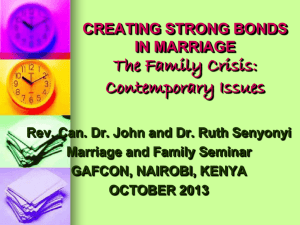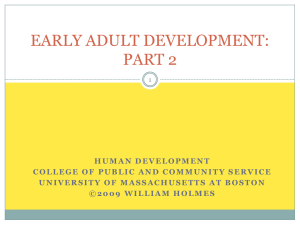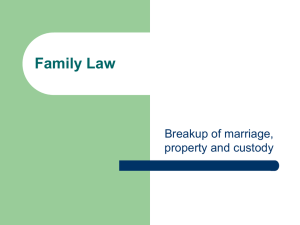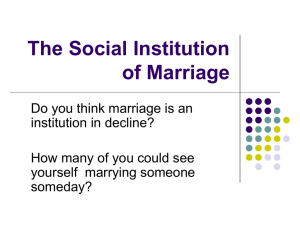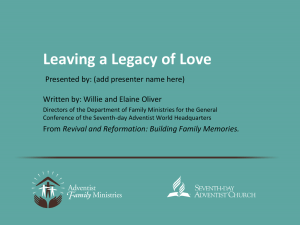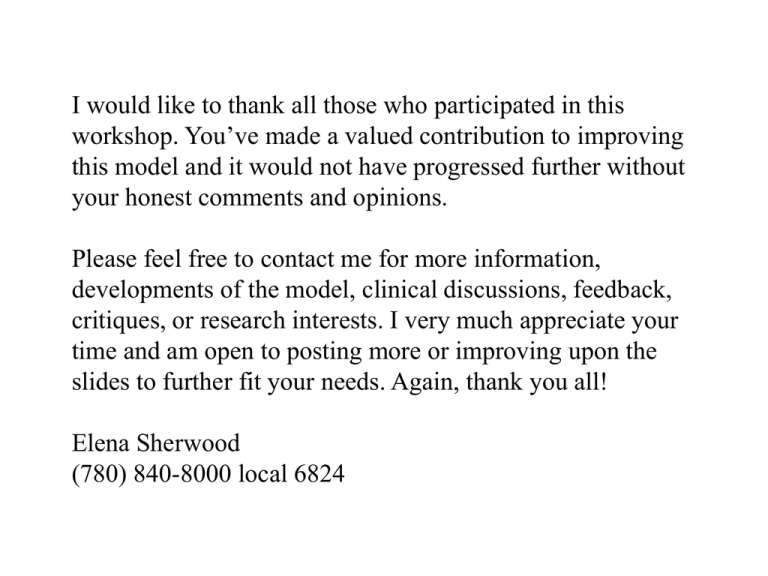
I would like to thank all those who participated in this
workshop. You’ve made a valued contribution to improving
this model and it would not have progressed further without
your honest comments and opinions.
Please feel free to contact me for more information,
developments of the model, clinical discussions, feedback,
critiques, or research interests. I very much appreciate your
time and am open to posting more or improving upon the
slides to further fit your needs. Again, thank you all!
Elena Sherwood
(780) 840-8000 local 6824
Resilient Marriage Model
Elena Sherwood, PhD, RSW
Clinical Social Worker
Emsherwo@ucalgary.ca
Elena.Sherwood@forces.gc.ca
Originated from:
The research question: What makes
Canadian military marriages strong?
The research project: Resilient
Canadian Military Marriages: A
Grounded Theory Approach
https://dspace.ucalgary.ca/handle/1880/46460
Resilient Marriage Model
Commitment
Conflicting
Cultural
Values
Intimacy
Resilient
Fused
Marriage
Marriage
Communicative
Faith
Adaptive
Trusting
Mature
Conflicting
Societal
Values
Respect
Figure 1. Note, the dark solid circle represents faith, enhanced sense of self and boundaries, elements
that preserve strong marriages according to those interviewed in this study.
© Elena Sherwood 2009 emsherwo@ucalgary.ca
ASSESSMENT FORM
The Structure of Marriage
The Maintenance of Marriage
•Intimacy (Sex and Friendship) __________________
____________________________________________
•Commitment ________________________________
____________________________________________
•Respect ____________________________________
____________________________________________
•Faith ________________________________________
_____________________________________________
Enhanced Sense of Self in Women _________________
_____________________________________________
•Boundaries ___________________________________
______________________________________________
The Face of Marriage
•Adaptability ________________________________
The Challenges of Marriage
___________________________________________
•Maturity ___________________________________
•Conflicting Cultural Values ______________________
___________________________________________
_____________________________________________
•Communication _____________________________
Conflicting Societal Values _______________________
___________________________________________
_____________________________________________
•Trust _____________________________________
___________________________________________
© Elena Sherwood 2009 emsherwo@ucalgary.ca
The Model
The Structure of Strong Canadian Military Marriage: Intimacy,
commitment and respect
The Face of Strong Canadian Military Marriage: Adaptable,
communicative, trusting and mature
The Maintenance of Strong Canadian Military Marriages: Faith,
enhanced sense of self and boundaries
The Challenges of Canadian Military Marriages: infidelity,
veneration of males and devaluation of women
© Elena Sherwood 2009 emsherwo@ucalgary.ca
Definitions
Structure
Intimacy was defined as having a deep and affectionate feeling of closeness towards one’s spouse, more
commonly described by the participants as “love”; words, phrase or sentence that reflected this
underlying connectedness was coded as intimacy.
Respect was defined here as the act of holding one’s marital partner in very high regard, along with his
or her accompanying thoughts, actions and feelings. Although the interviewees described various ways
in which respect was conveyed, for example some spoke respectfully of their spouse’s attributes while
others of the spouse themselves, they commonly showed that their partners were, in some way, valued
considerably. The needs of both partners’ were accommodated in current and future plans and the
relationship was treated with reverence. Acts of disrespect in marriage, however unintentional, had
detrimental effects.
Commitment here was defined in the context of a spouse’s determination to make the marriage work,
especially during hard times. The ability to wholeheartedly commit to the marital union was discussed
by every participant, each of whom declared it the foundation of a strong and lasting marriage.
Face
Maturity was defined here as the display of age appropriate, well thought-out behaviour that indicates
an awareness of consequences with respect to marital issues. Perhaps the most noteworthy display of
maturity was shown in the participants’ ability to keep a healthy point of view. No evidence was
found to suggest the presence of mind games, manipulation or similarly dysfunctional patterns.
Having realistic expectations of one’s mate further marked the existence of maturity in most of these
partners, wherein they understood that marriage was simply not perfect.
Communication was considered effective when thoughts and feelings flowed well within the marital
relationship. This included having established regular mechanisms to connect during absences, and
they claimed that they related well on a verbal, spiritual, and intellectual level. They identified calm
and reciprocal interactions as the main characteristics of communication. Good communication is
also rational. Partners were able to handle strong emotions such as grief, sadness, fear and anger,
rendering their communication intimate.
Trust was defined here as having the ability to rely on a partner’s overall integrity. Although there are
various ways of demonstrating trust, all such actions indicated that partners lived up to their marital
vows of fidelity, and that they trusted their spouses to act in the best interest of the marriage and
family. The informants identified two general aspects to this issue: the first entailed a tangible trust
wherein one handed over all control of household matters, and the second was an emotional trust
wherein one handed over control of one’s defenseless heart.
Maintenance
Faith was defined as the belief in the existence of a higher being, regardless of active or inactive
involvement in organized religion. Their lives were guided by faith and a solid belief in God. The
interviewees claimed that marital hardships were overcome because they had faith. The faith-based
participants reported five primary benefits to a religious conviction. Firstly, they were able to give to
God what was beyond their control; secondly, they saw all situations and challenges as opportunities
to do good; thirdly, religion held them accountable for actions that were un-witnessed by their
spouses; fourthly, faith emphasized the notion that both partners were equal within a marriage; and
fifthly, faith gave them individual and combined strength when they needed it most. A distinction was
found between religious and non- religious interviewees, as faith-based spouses understood the
necessity, eventuality and power of forgiveness. Religious beliefs aside, participants claimed that
strong military marriages were guided by the two core values of honesty, and having a strong sense of
right and wrong. While some referred to these as faith principles, others claimed that they were a
product of traditional or old-fashioned ways of thinking. Regardless of their origin and the means
with which they were maintained, the need to be honest was discussed, as well as conducting oneself
in a principled manner.
Enhance sense of self in women. High degrees of self-determination, self-assuredness, independence,
and self-awareness were noted in the women, and these were combined together into the code of
“enhanced sense of self” due to their inter-relatedness. The participants made 62 references to this
effect, and the characteristics appeared to be present in all the military wives affected by the study.
Self-determination was reflected in the women’s ability to make their own choices and functioning
was believed to be a product one’s own doing. The women described several instances when they had
simply had to learn to rely on themselves; they spoke of choice and believed that their husbands also
exercised self-determination with the marriage and family in mind. With respect to heightened selfawareness, all believed that both husbands and wives exerted considerable effort into staying in tune
with how they affected the marriage.
Boundaries All of these strong marriages possessed firm boundaries around the marital system. While
other relationships existed that were beneficial to the marriage, careful protection of the marital and
family unit appeared to be enforced. Some felt it necessary to set physical boundaries by residing at a
good distance from work and restricting their attendance to work-related gatherings, and they felt that
this reduced influence of career on their day-to-day lives. They also reported defining social
boundaries and this was done by choosing networks that were supportive of marriage and family.
Model Summary
A resilient Canadian military marriage is a union that is premised on intimacy, commitment and
respect, wherein marital partners are intent on keeping these structural components strong. Such a
marriage is described as adaptive, mature, trustful and communicative. It is held together and reenforced by the use of faith, an enhanced sense of self and healthy boundaries as represented by the
bolded circle, which overpower the clashing values of culture and society. The word “resilient” was
selected based on its ability to describe the kind of relationship that develops, when two people come
together and carry on healthily.
When the concepts are assembled into the resilient marriage model, a marriage may “weaken” or
experience increased distress if the presence of intimacy, commitment or respect is diminished, and
could alternatively strengthen when their prominence is firmly set. The marital contents of faith, an
enhanced sense of self, and boundaries constantly nurture the foundational core of the marriage. How
well the structural elements are established seems to account for varying degrees of marital strength.
This variation in functionality seemed to depend on whether respect, intimacy and commitment were
paramount. Doubts about a partner in any of these areas suggest higher levels of discontent when
times were hard. Whether or not both partners felt deeply loved, whether or not their contributions
were valued, and whether or not they were devoted to preserving the marital union, seemed to directly
affect the level of marital strength achieved.
The resilient marriage model provides a systematic way of understanding marital
health. While these constructs are not new and have been of interest to scholars for quite
some time, the value and novelty here lie in their unique positioning, wherein they are
assembled into a usable and practical model for explaining marital health. The strength of this
emergent model is best revealed by its organizing power, wherein any construct likely to be
associated with marital relationships can be found within it. Alternatively, the presence or
absence of such concepts can also be readily identified so the model is a preliminary guiding
map for those interested in marital health within this group.
The structural, descriptive, protective, and conflictual levels identified here ensure
easy recognition of a particular concept’s relevance, wherein its location within the model
designates it particular worth. The presence of all structural components, for example, readily
suggests that a strong marriage exists, and the absence of any one of them may be cause for
immediate and grave concern. There is also the potential for using this model with varied
cultural groups; slight modifications can be made regarding the impinging stressors that
would be intrinsic to a specific population, and instituting a minor label change does not seem
to compromise the integrity of the model.
Although the model is presented in a clear way, it requires a comprehensive
understanding of how the concepts are used within it, and strict adherence to how they were
intended may prove difficult for some. It is referred to as a working model and rightfully so,
as its eclecticism and versatility have not yet been determined. Another limitation of the
model is that the definitions used for these terms were subjectively assigned for the purpose
of the research.
Model Application
1.
As this model is in early development it is only intended to be used as an assessment aide in similar
fashion to an Ecomap or Genogram.
2.
The Assessment Form can be completed with an individual or with both partners present. Feel free to
incorporate scales (such as 1-10) for your ease, though descriptive words or phrases about the
prominence of the construct will suffice.
3.
Once the form is complete evaluate the general areas of strong, weak or absent constructs and view
them in the context of the illustrated model. This will assist in identifying existing areas of solidity
and areas wherein interventive efforts could be best focused on.
4.
The form can be completed at various stages of intervention; it could be useful at pre-treatment, over
a number of sessions as part of history gathering, introduced as a goal for intervention and
incorporated into that phase, after treatment and at follow up.
5.
Its likely that completing the model with the couple will give you a good intuitive sense of the most
volatile areas in the union, and provide an immediate target for work depending on its severity (i.e.
domestic violence, addictions, psychiatric and/or mental health conditions, urgent need for advocacy).
6.
Culture is the “set of shared attitudes, values, goals and practices that characterize an institution or
organization” (Merriam-Webster, 2003, p. 304). Cultural elements of the military population are:
uniformity, discipline, the mandate to protect the nation, isolation, duty related separation and
patriarchal nature. When examining the couple you are working with, what cultural values are they
affected by and how might these negatively impact the marriage?
Sherwood, E. (2008). Marital strength in Canadian military couples: A
grounded theory approach. University of Calgary, Doctoral Thesis.
http://hdl.handle.net/1880/46460
Sherwood, E. (2007). Clinical Assessment of Canadian Military Marriages.
Clinical Social Work Journal
http://www.springerlink.com/content/66224160x4511u04/?p=f47f8d788
28648e59d230516ac3170f6pi=4
Slaughter, S., Dean, Y., Knight, H., Krieg, B., Mor, P., Nour, V., Polegato, E.,
Seneviratne, C., Shenfield, D. & Sherwood, E. (2007).The inevitable
pull of the river’s current: Interpretations derived from a single text
using multiple research traditions. Qualitative Health Research, 17(4) p.
548-561. http://qhr.sagepub.com/cgi/reprint/17/4/548
De Guzman. E. (1996). Conjoint counselling for spouse abuse couples: A
systemic approach. University of Manitoba, Winnipeg. Master’s Thesis.
Available at Proquest Dissertation Abstracts.


